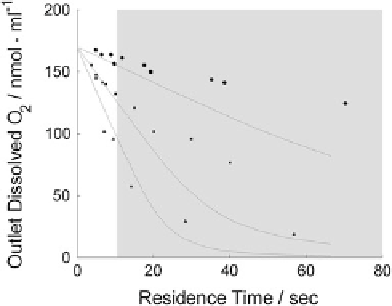Biomedical Engineering Reference
In-Depth Information
Fig. 5 Predicted and measured DO concentration versus residence time for the translumenal
bioreactor configuration. The residence time here is tissue thickness divided by transmural
velocity, corresponding to flow rates ranging from 50 to 400 lL/min. The shaded region
indicates transmural flow velocities yielding Pe
r
\ 1. (- - -) Predicted DO concentrations for (top
to bottom)459 10
6
, 135 9 10
6
, and 225 9 10
6
cells/mL. Measured outlet DO for (filled circle)
low, (filled square) medium and (filled triangle) high cell densities (targeted cell densities to
compare
to
predictions).
Note
that
the
measured
DO
inlet
in
these
measurements
was
165 nmol mL
-1
and is also reflected in the predictions for consistency. From [
23
]
The result of the combination flow case is noteworthy when also understanding
the pressures required to provide DO uniformity along the ablumenal surface in
comparison to the transmural flow cases, which appear very similar. In the
transmural flow case, the lumenal pressures reach nearly 200 mmHg. For a
developing tissue, this can be a detrimental pressure resulting in damage to the
integrity of the construct. In contrast, the combination case can achieve compa-
rable DO uniformity with much lower lumenal pressures (10-15 mmHg) since
there is greater DO uniformity along the lumenal surface imparted by much higher
axial flow.
Furthermore, increased transmural flow velocity increases shear stress on the
cells within the tissue. Hydraulic conductivity plays a central role in these effects.
As the tissue compacts due to cell traction forces and the cells deposit collagen and
other extracellular matrix, the tissue becomes denser and less permeable to fluid
flow, so the hydraulic conductivity, and thus j, decreases. This, in turn, yields an
increase in the shear stress according to Eq.
3.7
. Given the higher lumenal pres-
sures in the translumenal flow case, the detrimental consequences of higher
interstitial shear are more likely compared to the combination flow case.
The model was verified by comparing the computed total radial molar flux of
oxygen to measurements taken on the inlet and outlet streams. The total molar flux
was found by integration along the ablumenal boundary in COMSOL for the case
of translumenal flow. Dividing by the volumetric flow rate, which ranged from
50-400 lL/min, yielded the average DO concentration predicted in the transmural
outlet lines, reflecting oxygen consumption by cells within the engineered tissue.

Search WWH ::

Custom Search